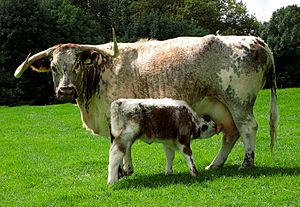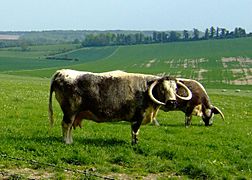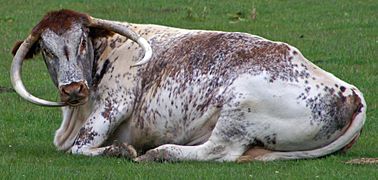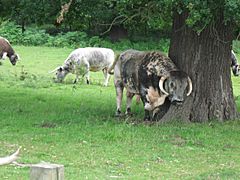English Longhorn facts for kids

English Longhorn cow and calf
|
|
| Country of origin | England |
|---|---|
| Distribution | UK, Ireland, Germany and New Zealand |
| Use | Beef, formerly draught and dairy |
| Traits | |
| Weight |
|
| Height |
|
| Coat | Red, brown or grey and white; often blotched in areas. |
| Horn status | Long, cream horns that curve around the face. |
|
|
The English Longhorn cattle are a special type of beef cattle known for their long horns. They originally came from a northern part of England called Craven. These cows are usually brown and white. They were once called Lancashire cattle.
Long ago, English Longhorns were used as working animals. This means they helped pull carts or farm equipment. Their strong bodies were perfect for this job. People also collected their milk. It had a lot of butterfat, which was great for making butter and cheese. Back then, a farmer might have owned one or two cows. The village's main bull would have belonged to the Lord of the Manor.
Their most famous feature is their long, curved horns. These horns make them look unique. Even though their horns look impressive, these cattle are usually very friendly. They also tend to live longer than many other types of cows. Another good thing about them is that mother cows often have an easy time giving birth to their calves. You can spot an English Longhorn by the white stripe along their spine and under their bellies.
It's important not to confuse English Longhorns with the Texas Longhorn breed. They are different, even though both are called "Longhorn cattle."
Contents
How the English Longhorn Breed Was Improved
Long-horned oxen were common in Craven as early as the 1500s and 1600s. However, the English Longhorn breed was greatly improved for meat production by a farmer named Robert Bakewell. He lived in Dishley, near Loughborough. At the time, many people were moving to towns and cities during the Industrial Revolution. This meant a lot more meat was needed to feed everyone.
Robert Bakewell used a method called selective breeding. This means he carefully chose which cows and bulls would have babies. He picked the ones with the best traits for meat. His work made the "Dishley Longhorn" very popular in the late 1700s.
Today, you can still find English Longhorns in places like Stanley's Springbarrow Farm in Leicestershire. There's also a herd at Thoresby Estate in Nottinghamshire. A small group has even been brought back to Calke Abbey in Derbyshire. The Harpur-Crewe family, who lived there, traditionally kept these cattle.
English Longhorns in Popular Culture
English Longhorns have appeared in movies and TV shows. For example, two English Longhorns were in the 1995 movie Braveheart. They pulled a cart carrying the injured father of a young William Wallace.
A famous chef named Heston Blumenthal even chose Longhorn beef as the "perfect" beef. He said this in his TV series, In Search of Perfection. He thought it was better than even more famous types of beef, like Kobe beef.
You can also find Longhorn cattle roaming freely on the Knepp estate in Sussex. This is part of a "rewilding" project, which you can read about in the book Wilding by Isabella Tree.
English Longhorn vs. Texas Longhorn
It's easy to tell the two types of Longhorns apart if you know what to look for.
Horn Shape and Color
English Longhorns have horns that curve downwards and around their face. They almost frame the face. On the other hand, Texas Longhorns' horns usually grow upwards and outwards, away from their face.
Another big difference is their color. English Longhorns are only brown and white. Texas Longhorn cattle, however, can be almost any color a cow can be, except for blue-roan.
Gallery
See also
 In Spanish: Longhorn (raza bovina) para niños
In Spanish: Longhorn (raza bovina) para niños






